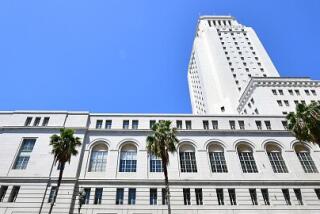Los Angeles ponders extending yellow-light times
In the wake of Los Angeles’ decision to kill its controversial red-light camera traffic enforcement program, new City Hall attention is being focused on the potential safety benefits of extending the length of yellow lights and other signal times at busy intersections.
Some studies indicate that simple, low-cost changes to signal durations can significantly reduce accidents.
City Councilman Bill Rosendahl last week proposed studying the effects of increasing yellow light times at 32 intersections where cameras used to automatically photograph and ticket drivers entering against a red. In addition, he wants to review a so-called all-stop option, a practice already in place in which signals turn red in every direction before permitting any traffic to pass.
The idea caught on with some council members during this summer’s debates over the red-light cameras and after reports that smaller cities, such as Loma Linda, had positive results after they ditched their cameras and changed yellow-light times.
Another benefit is that changing signal times can be done at relatively low cost and without the drama attached to enforcing costly fines for less serious right-turn violations.
“Intersections which exhibit a higher than average number of red-light-related collisions most likely have either a yellow phase or all-red phase which is too short,” said Jay Beeber of the anti-camera group Safer Streets L.A. “Oftentimes, both problems exist at the same intersection.”
Changing the signal timing, he said, would most likely eliminate “the vast majority of collisions at these locations.”
But city Transportation Department officials pushed back, saying that they had already optimized signal timing at those 32 intersections, and the proposal was held. Now, Rosendahl wants to continue talking about how to better manage signals but also wants the Transportation Department to take an “objective look” at L.A.’s busiest intersections, measured by both traffic and pedestrian flow.
“It’s a new day, and people are doing a lot more walking” and are concerned about the length of pedestrian signals, Rosendahl said.
Councilman Paul Koretz said he wants the department, or an independent contractor, to take a thorough look at the city’s signals and see whether changing times could help even if only by a small fraction. Officials with the mayor’s office said they would probably support a similar study.
Most intersections have up to two seconds when all traffic is stopped, and most yellow lights at the city’s 4,400 signaled intersections now last from three to 4.3 seconds, with a few lasting as long as six seconds, officials said.
Those lights are set based on complicated formulas designed to give approaching motorists enough time to judge if they should stop or can safely pass through the intersection.
Transportation officials last week appeared reluctant to change their approach and said state guidelines give them only a little leeway. But council members and some activists challenged that contention.
Transportation officials also said there is an ongoing internal practice to look at signal times whenever work is being done on an intersection or when problems arise, and that monitoring all of the city’s intersections at once would be overly burdensome.
But Panos Prevedouros, a professor of civil and environmental engineering at the University of Hawaii at Manoa, said that manipulating times has been shown to increase safety in many circumstances and that yellow lights don’t get enough respect.
It is “the critical interval that comes into play,” Prevedouros said. “The whole thing is the yellow.”
More to Read
Start your day right
Sign up for Essential California for news, features and recommendations from the L.A. Times and beyond in your inbox six days a week.
You may occasionally receive promotional content from the Los Angeles Times.






